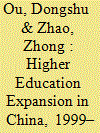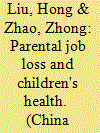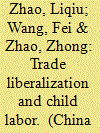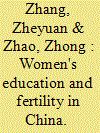|
|
|
Sort Order |
|
|
|
Items / Page
|
|
|
|
|
|
|
| Srl | Item |
| 1 |
ID:
159025


|
|
|
|
|
| Summary/Abstract |
The paper studies the levels and changes in wage inequality among Chinese rural-urban migrants during 2002–2007. Using data from two waves of national household surveys, we find that wage inequality among migrants decreased significantly between 2002 and 2007. Our analysis on the wage distribution further shows that the high-wage migrants experienced slower wage growth than middle- and low-wage migrants—a primary cause of declining inequality of migrants. By using distributional decomposition methods based on quantile regression, we find that an overall between-group effect dominates in the whole wage distribution, which means that the change in returns to the characteristics (education, experience and other employment characteristics) plays a key role, but on the upper tails of the wage distribution, the within group effect (residual effect) dominates, implying that the unobservable factors or institutional barriers do not favor the migrants at the top tail of the wage distribution. We also study wage differential between migrants and urban natives, and find that though the wage gap is narrowed, the gap at the upper wage distribution is becoming bigger. Overall, the results suggest that there exists a strong “glass ceiling” for migrants in the urban labor market.
|
|
|
|
|
|
|
|
|
|
|
|
|
|
|
|
| 2 |
ID:
186214


|
|
|
|
|
| Summary/Abstract |
We examine the impact of China's higher education expansion on labor market outcomes for young college graduates using China's 2005 1 Percent Population Sample Survey. Exploiting variations in the expansion of university places across provinces and high school cohorts between 1999 and 2003, we apply a difference-in-differences model and take into account the demand-side effect by using the Bartik index. We find that the expansion of higher education in China decreased unemployment rates among males and college graduates in the short term. However, the policy decreased women's labor force participation and individual earnings in high-skilled white-collar jobs. We further discuss potential channels affecting the outcomes that were observed. Our results illustrate the broad economic benefits of higher education. The findings shed new light on the contribution of young skilled labor in the economic growth of China and call for policies that can alleviate the short-term negative impact of higher education on individual students and maximize human capital. Our study also provides an interesting example of the consequences of the unequal expansion of higher education opportunities on the labor market of an emerging economy.
|
|
|
|
|
|
|
|
|
|
|
|
|
|
|
|
| 3 |
ID:
136271


|
|
|
|
|
| Summary/Abstract |
Beginning in the mid 1990s, China sped up its urban labor market reform and drastically restructured its state-owned enterprises (SOEs), which resulted in massive layoff of the SOEs' workers and a high unemployment rate. In this paper, we investigate the impact of parental job loss on their children's health, using six waves of the China Health and Nutrition Survey covering the period from 1991 to 2006. We find that paternal job loss has a significant negative effect on children's health, while maternal job loss has no significant effect. The rationale behind the findings is that the income loss resulting from maternal job loss is much smaller; meanwhile, the unemployed mothers are likely to increase their time inputs to child care, and this may alleviate the negative effect of maternal job loss. Our findings from a fixed effects model are robust to various specifications and alternative approaches.
|
|
|
|
|
|
|
|
|
|
|
|
|
|
|
|
| 4 |
ID:
182720


|
|
|
|
|
| Summary/Abstract |
This paper exploits a quasi-natural experiment – the U.S. granting of Permanent Normal Trade Relations (PNTR) to China after China's accession to the World Trade Organization – to examine whether trade liberalization affects the incidence of child labor. PNTR permanently set U.S. duties on Chinese imports at low Normal Trade Relations (NTR) levels and removed the uncertainty associated with annual renewals of China's NTR status. We find that the PNTR was significantly associated with the rising incidence of child labor in China. A one percentage point reduction in expected export tariffs raises the odds of child labor by a 1.2 percentage point. The effects are greater for girls, older children, rural children, and children with less-educated parents. The effect of trade liberalization on the incidence of child labor, however, tends to weaken in the long run, probably because trade liberalization can induce exporters to upgrade technology and thus have less demand for unskilled workers.
|
|
|
|
|
|
|
|
|
|
|
|
|
|
|
|
| 5 |
ID:
192392


|
|
|
|
|
| Summary/Abstract |
Using data from the China Family Panel Studies, this paper exploits the Compulsory Education Law of China implemented in the 1980s to empirically examine the causal impact of women's education on fertility in rural China by difference-in-differences methods. The results show that an additional year of schooling lowered the number of children a woman would have by approximately 0.09 children, postponed the age of first childbirth by 0.7 years, and reduced the probability of having a second child or more children by 0.18 among those mothers whose first child was a girl. In addition to the income effect, these results are also partly explained by more educated women preferring quality to quantity of children, placing a greater value on leisure and no longer perceiving children as the sole focus in their lives.
|
|
|
|
|
|
|
|
|
|
|
|
|
|
|
|
|
|
|
|
|